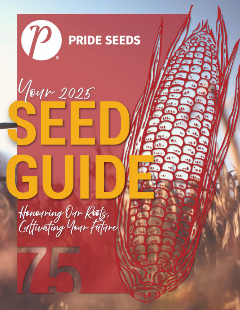WELCOME JEREMY O'SHEA TO PRIDE SEEDS

Enhance your knowledge and stay ahead with PRIDE SEEDS Corn and Soybean School videos.
Browse our selection of products below
___________________________________________________________________________________________________________________________________________

2024-2025 PRIDE Seeds Product GuideYou can find all of our products on the website, including supporting performance data and create your own personalized guide called My Guide. You can also download the digital version of our printed product guide which includes product comparison charts. |
SHOP THE PRIDE SEEDS E-STORE
-7.png?sfvrsn=87920db3_3)
STAY UP-TO-DATE WITH PRIDE SEEDS LATEST BLOGS, NEWS AND ARTICLES
Corn Planting Checklist
1. Planting Population – target 28,000-34,000 seeds/ac (rate influenced on numerous factors – climate, soil type & productivity, resources available, planting date, hybrid characteristics, chu region, end use, economics)
1 bag = 80,000 kernels/bag > 32,000 seeds/ac = 2.5 bags/acre; 34,000 ac/bag = 2.35 ac/bag
2. Plant corn using a planter > consistent seed placement & consistent seed depth
3. Depth – target planting depth is 1.5 – 2.5”; plant into 0.5” of moisture
- Target this depth to achieve good seed-to-soil contact and good development on the nodal root system (critical for structural support and nutrient and water uptake)
- Goal: even planting depth > even emergence
- Too shallow is worse than too deep
| Too Shallow: < 1.5" | Too Deep: > 2.5” |
|
|
4. Soil Temperature – 10 ℃ at planting depth with a 48 hr warming trend
- Corn does not germinate below 10 ℃; corn seed is very temperature sensitive
- Wait for warm soils to avoid imbibitional chilling (within 24 hrs of planting) & cold injury
- Imbibitional chilling occurs when there is a drastic change in the water temperature during imbibition. The critical time for this to occur is within 24 hours of planting.
- Cold Injury is when there is a change in the soil temperature after the seed has imbibed water. Cold injury is typically less severe than imbibitional chilling.
- Cool soils + cool weather > better to leave the seed in the bag
5. Seed Bed Preparation – plant into a firm seed bed with residue well managed
- Poor residue management/ no-till fields can result in hair-pinning of the emerging seedling
- Want seedbed to be firm because seed-to-soil contact is increased and for good nodal root development
- Excess tillage can result in crusting & compaction
- Avoid planting and tilling wet soils
6. Planter Speed – most planters run at 4-5 mph at the fastest
- As speed increases, spacing within the row and depth uniformity is reduced
- Speed is dictated by planters metering abilities
7. Emergence – Optimal emergence conditions: 10 - 16 days; Unfavorable emergence conditions: up to 21 days.
- Even emergence is critical; yield loss from uneven emergence can range from 5-10%
CORN FERTILITY TIPS
Nitrogen (N)
- Critical to profitability > corn has a very high response to N
- Application
- Pre-plant – broadcast & incorporate
- Side band – 4 inches from seed row High salt index products – ammonium nitrate, urea, potash
- Fertigation (through the irrigation pivot)
- Pre-plant – broadcast & incorporate
- Grazing – consider the N left from manure and urine
- General Recommendation Rates
- 1 lb actual N/ target bu of grain
- 150 bu = 150 lbs actual N
- 8-10 lbs of N/ target ton
- 21 ton = 189 lbs actual N
- 1 lb actual N/ target bu of grain
- 63% of plant N is taken up by pollination; 37% of N is taken up during grain fill
- 50% of N supply used between V8 and VT
Phosphorus (P)
- Early season development & growth of root system
- Cold soils have a very slow release of plant available P > Include P in starter fertilizer
- Important after tasseling – continually taken up during grain fill > long season supply is critical
- Starter P response can vary year-to-year based on:
- soil moisture, temperature, crop vigour, hybrid
- Include in the seed row or close to the seed – immobile nutrient
- Depending on soil levels: 10 – 40 lbs P2O5
- Band phosphorus
- Side banded
- Spring, fall or at planting
- Rotation – not recommended to plant corn after canola
Potassium (K)
- Associated with movement of water, nutrients, and carbohydrates within the plant and stalk strength
- Rapid K uptake between V6 and VT/R1 timing
- Application: banding is more efficient than broadcast
- Watch the salinity of the fertilizer
Sulfur (S)
- Available S vs elemental S
- N:S ratio – 10-12:1
- Know what the crop needs and apply for that season
TAKE PRIDE IN YOUR INBOX
Expert advice, news and information
THE PRIDE SEEDS ADVANTAGE
Farming is one of the most demanding industries in the world, subject to a variety of factors such as time, weather, and global pressures. You know this every time you look out the window and think about the field in front of you. Growers and dealers deserve an advantage: The PRIDE Seed Advantage.
LEARN MORETHE PRIDE SEEDS ADVANTAGE
Every year PRIDE Seeds works hard to produce leading-edge products that enable success where it matters most, on your farm. Our dedicated team strives to provide sales expertise, agronomy support, quality production, and service tailored to meet your needs.
LEARN MORE

Leave a commentOrder by
Newest on top Oldest on top